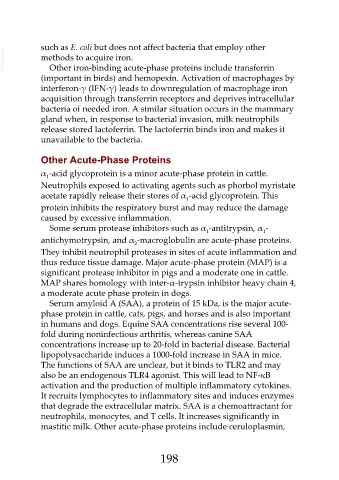Page 198 - Veterinary Immunology, 10th Edition
P. 198
such as E. coli but does not affect bacteria that employ other
VetBooks.ir methods to acquire iron.
Other iron-binding acute-phase proteins include transferrin
(important in birds) and hemopexin. Activation of macrophages by
interferon-γ (IFN-γ) leads to downregulation of macrophage iron
acquisition through transferrin receptors and deprives intracellular
bacteria of needed iron. A similar situation occurs in the mammary
gland when, in response to bacterial invasion, milk neutrophils
release stored lactoferrin. The lactoferrin binds iron and makes it
unavailable to the bacteria.
Other Acute-Phase Proteins
α -acid glycoprotein is a minor acute-phase protein in cattle.
1
Neutrophils exposed to activating agents such as phorbol myristate
acetate rapidly release their stores of α -acid glycoprotein. This
1
protein inhibits the respiratory burst and may reduce the damage
caused by excessive inflammation.
Some serum protease inhibitors such as α -antitrypsin, α -
1 1
antichymotrypsin, and α -macroglobulin are acute-phase proteins.
2
They inhibit neutrophil proteases in sites of acute inflammation and
thus reduce tissue damage. Major acute-phase protein (MAP) is a
significant protease inhibitor in pigs and a moderate one in cattle.
MAP shares homology with inter-α-trypsin inhibitor heavy chain 4,
a moderate acute phase protein in dogs.
Serum amyloid A (SAA), a protein of 15 kDa, is the major acute-
phase protein in cattle, cats, pigs, and horses and is also important
in humans and dogs. Equine SAA concentrations rise several 100-
fold during noninfectious arthritis, whereas canine SAA
concentrations increase up to 20-fold in bacterial disease. Bacterial
lipopolysaccharide induces a 1000-fold increase in SAA in mice.
The functions of SAA are unclear, but it binds to TLR2 and may
also be an endogenous TLR4 agonist. This will lead to NF-κB
activation and the production of multiple inflammatory cytokines.
It recruits lymphocytes to inflammatory sites and induces enzymes
that degrade the extracellular matrix. SAA is a chemoattractant for
neutrophils, monocytes, and T cells. It increases significantly in
mastitic milk. Other acute-phase proteins include ceruloplasmin,
198

